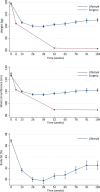Weight Loss and Heart Failure: A Nationwide Study of Gastric Bypass Surgery Versus Intensive Lifestyle Treatment
- PMID: 28258170
- PMCID: PMC5404408
- DOI: 10.1161/CIRCULATIONAHA.116.025629
Weight Loss and Heart Failure: A Nationwide Study of Gastric Bypass Surgery Versus Intensive Lifestyle Treatment
Abstract
Background: Associations of obesity with incidence of heart failure have been observed, but the causality is uncertain. We hypothesized that gastric bypass surgery leads to a lower incidence of heart failure compared with intensive lifestyle modification in obese people.
Methods: We included obese people without previous heart failure from a Swedish nationwide registry of people treated with a structured intensive lifestyle program and the Scandinavian Obesity Surgery Registry. All analyses used inverse probability weights based on baseline body mass index and a propensity score estimated from baseline variables. Treatment groups were well balanced in terms of weight, body mass index, and most potential confounders. Associations of treatment with heart failure incidence, as defined in the National Patient Register, were analyzed with Cox regression.
Results: The 25 804 gastric bypass surgery patients had on average lost 18.8 kg more weight after 1 year and 22.6 kg more after 2 years than the 13 701 lifestyle modification patients. During a median of 4.1 years, surgery patients had lower heart failure incidence than lifestyle modification patients (hazard ratio, 0.54; 95% confidence interval, 0.36-0.82). A 10-kg achieved weight loss after 1 year was related to a hazard ratio for heart failure of 0.77 (95% confidence interval, 0.60-0.97) in both treatment groups combined. Results were robust in sensitivity analyses.
Conclusions: Gastric bypass surgery was associated with approximately one half the incidence of heart failure compared with intensive lifestyle modification in this study of 2 large nationwide registries. We also observed a graded association between increasing weight loss and decreasing risk of heart failure.
Keywords: bariatric surgery; diet, reducing; gastric bypass; heart failure; weight loss.
© 2017 The Authors.
Figures



Similar articles
-
Weight loss, adverse events, and loss to follow-up after gastric bypass in young versus older adults: A Scandinavian Obesity Surgery Registry study.Surg Obes Relat Dis. 2018 Sep;14(9):1319-1326. doi: 10.1016/j.soard.2018.06.012. Epub 2018 Jun 24. Surg Obes Relat Dis. 2018. PMID: 30056048
-
Surgical obesity treatment and the risk of heart failure.Eur Heart J. 2019 Jul 1;40(26):2131-2138. doi: 10.1093/eurheartj/ehz295. Eur Heart J. 2019. PMID: 31089682 Free PMC article.
-
Bleeding during laparoscopic gastric bypass surgery as a risk factor for less favorable outcome. A cohort study from the Scandinavian Obesity Surgery Registry.Surg Obes Relat Dis. 2017 Oct;13(10):1735-1740. doi: 10.1016/j.soard.2017.05.028. Epub 2017 Jun 2. Surg Obes Relat Dis. 2017. PMID: 28688860
-
Complex interaction of obesity, intentional weight loss and heart failure: a systematic review and meta-analysis.Heart. 2020 Jan;106(1):58-68. doi: 10.1136/heartjnl-2019-314770. Epub 2019 Sep 17. Heart. 2020. PMID: 31530572
-
Metabolic implications of obesity: before and after gastric bypass.Gastroenterol Clin North Am. 2005 Mar;34(1):9-24. doi: 10.1016/j.gtc.2004.12.009. Gastroenterol Clin North Am. 2005. PMID: 15823435 Review.
Cited by
-
Epidemiology and Clinical Features of Heart Failure with Preserved Ejection Fraction.Card Fail Rev. 2022 Aug 4;8:e27. doi: 10.15420/cfr.2022.06. eCollection 2022 Jan. Card Fail Rev. 2022. PMID: 35991117 Free PMC article. Review.
-
Association of Intensive Lifestyle Intervention, Fitness, and Body Mass Index With Risk of Heart Failure in Overweight or Obese Adults With Type 2 Diabetes Mellitus: An Analysis From the Look AHEAD Trial.Circulation. 2020 Apr 21;141(16):1295-1306. doi: 10.1161/CIRCULATIONAHA.119.044865. Epub 2020 Mar 5. Circulation. 2020. PMID: 32134326 Free PMC article. Clinical Trial.
-
Biomarkers, myocardial fibrosis and co-morbidities in heart failure with preserved ejection fraction: an overview.Arch Med Sci. 2018 Jun;14(4):890-909. doi: 10.5114/aoms.2018.76279. Epub 2018 Jun 11. Arch Med Sci. 2018. PMID: 30002709 Free PMC article.
-
Italian Association of Hospital Cardiologists position paper-obesity in adults: a clinical primer.Eur Heart J Suppl. 2024 May 16;26(Suppl 2):ii221-ii235. doi: 10.1093/eurheartjsupp/suae031. eCollection 2024 Apr. Eur Heart J Suppl. 2024. PMID: 38784672 Free PMC article.
-
Refocusing on the Primary Prevention of Heart Failure.Curr Treat Options Cardiovasc Med. 2020 Jul;22(7):13. doi: 10.1007/s11936-020-00811-3. Epub 2020 May 29. Curr Treat Options Cardiovasc Med. 2020. PMID: 33707937 Free PMC article.
References
-
- Di Cesare M, Bentham J, Stevens GA, Zhou B, Danaei G, Lu Y, Bixby H, Cowan MJ, Riley LM, Hajifathalian K, Fortunato L, Taddei C, Bennett JE, Ikeda N, Khang YH, Kyobutungi C, Laxmaiah A, Li Y, Lin HH, Miranda JJ, Mostafa A, Turley ML, Paciorek CJ, Gunter M, Ezzati M NCD Risk Factor Collaboration (NCD-RisC) Trends in adult body-mass index in 200 countries from 1975 to 2014: a pooled analysis of 1698 population-based measurement studies with 19.2 million participants. Lancet. 2016;387:1377–1396. - PMC - PubMed
-
- Ambrosy AP, Fonarow GC, Butler J, Chioncel O, Greene SJ, Vaduganathan M, Nodari S, Lam CS, Sato N, Shah AN, Gheorghiade M. The global health and economic burden of hospitalizations for heart failure: lessons learned from hospitalized heart failure registries. J Am Coll Cardiol. 2014;63:1123–1133. doi: 10.1016/j.jacc.2013.11.053. - PubMed
-
- Kenchaiah S, Evans JC, Levy D, Wilson PW, Benjamin EJ, Larson MG, Kannel WB, Vasan RS. Obesity and the risk of heart failure. N Engl J Med. 2002;347:305–313. doi: 10.1056/NEJMoa020245. - PubMed
-
- Aune D, Sen A, Norat T, Janszky I, Romundstad P, Tonstad S, Vatten LJ. Body mass index, abdominal fatness, and heart failure incidence and mortality: a systematic review and dose-response meta-analysis of prospective studies. Circulation. 2016;133:639–649. doi: 10.1161/CIRCULATIONAHA.115.016801. - PubMed
Publication types
MeSH terms
Grants and funding
LinkOut - more resources
Full Text Sources
Other Literature Sources
Medical

